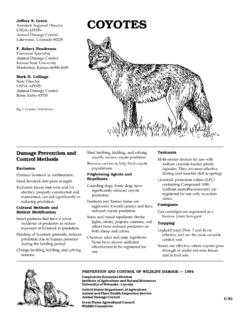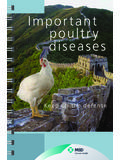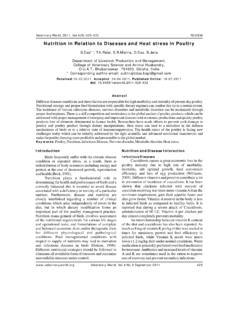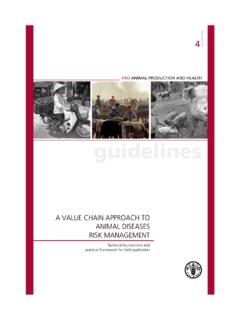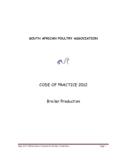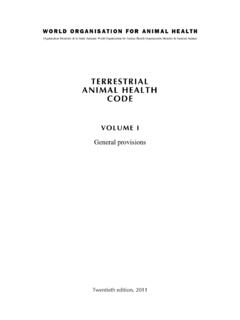Transcription of HOUSE SPARROWS - ICWDM Home Page
1 Metal projections (Nixalite andCat Claw ).ToxicantsFenthion in Rid-A-Bird toxic , automatic, and triggered guns and small shot and BB MethodsNest SPARROWSD amage Prevention andControl MethodsExclusionBlock entrances larger than 3/4 inch(2 cm).Design new buildings or alter old onesto eliminate roosting and plastic bird netting or overheadlines to protect high-value MethodsRemove roosting bird resistant , alarm calls, , motorized hawks, bal-loons, (Avitrol ).IdentificationThe HOUSE or English sparrow (Fig. 1)is a brown, chunky bird about 5 3/4inches (15 cm) long, and very commonin human-made habitats. The male hasa distinctive black bib, white cheeks, achestnut mantle around the graycrown, and chestnut-colored featherson the upper wings.
2 The female andyoung are difficult to distinguish fromsome native SPARROWS . They have aplain, dingy-gray breast, a distinct,buffy eye stripe, and a streaked black bib and chestnut-coloredfeathers on the wings are the first signsof male plumage and appear on theyoung birds within weeks of leavingthe AND CONTROL OF WILDLIFE DAMAGE 1994 Cooperative Extension DivisionInstitute of Agriculture and Natural ResourcesUniversity of Nebraska - LincolnUnited States Department of AgricultureAnimal and Plant Health Inspection ServiceAnimal Damage ControlGreat Plains Agricultural CouncilWildlife CommitteeWilliam D. FitzwaterDirectorNew Mexico OutdoorCommunicators7104 Bellrose Avenue, NEAlbuquerque, New Mexico 87110 Fig. 1. HOUSE sparrow, Passer (left) and female (right).
3 E-102 RangeThe HOUSE sparrow was first intro-duced in Brooklyn, New York, fromEngland in 1850 and has spreadthroughout the HOUSE sparrow is found in nearlyevery habitat except dense forest,alpine, and desert environments. Itprefers human-altered habitats, par-ticularly farm areas. While still themost common bird in most urbanareas, HOUSE sparrow numbers havefallen significantly since they peaked inthe 1920s, when food and wastes fromhorses furnished an unlimited supplyof HabitsHouse SPARROWS are primarily grani-vorous. Plant materials (grain, fruit,seeds, and garden plants) make up96% of the adult diet. The remainderconsists of insects, earthworms, andother animal matter. Nestlings, how-ever, are fed mostly animal , bread crumbs, and refusefrom fast-food restaurants can supportsparrow populations in urban Biology,Reproduction, andBehaviorBreeding can occur in any month but ismost common from March throughAugust.
4 The male usually selects a nestsite and controls a territory centeredaround it. Nests are bulky, roofedaffairs, built haphazardly and withoutthe good workmanship displayed byother weaver finches, the group towhich the HOUSE sparrow are loosely sexes feed and take care of theyoung, although the female does mostof the brooding. From 3 to 7 eggs arelaid, 4 to 5 being the most takes 10 to 14 days, and theyoung stay in the nest for about 15days. They may still be fed by theadults for another 2 weeks after leav-ing the SPARROWS are aggressive andsocial, both of which increases theirability to compete with most nativebirds. SPARROWS do not migrate. Stud-ies have shown that 90% of the adultswill stay within a radius of 1 1/4 miles(2 km) during the nesting occur when the young setup new territories.
5 Flocks of juvenilesand nonbreeding adults will move 4 to5 miles (6 to 8 km) from nesting sites toseasonal feeding is highest during the firstyear of life. Few SPARROWS survive inthe wild past their fifth season. Oneindividual, however, lived in captivityfor 23 years. While HOUSE SPARROWS aretolerant of disturbance by humans,they can in no way be consideredtame. Their success lies in their abilityto exploit new habitats, particularlythose influenced by SPARROWS consume grains infields and in storage. They do notmove great distances into grain fields,preferring to stay close to the shelter ofhedgerows. Localized damage can beconsiderable since SPARROWS often feedin large numbers over a small damage crops by peckingseeds, seedlings, buds, flowers, vege-tables, and maturing fruits.
6 They inter-fere with the production of livestock,particularly poultry, by consumingand contaminating feed. Because theylive in such close association withhumans, they are a factor in the dis-semination of diseases (chlamydiosis,coccidiosis, erysipeloid, Newcastle s,parathypoid, pullorum, salmonellosis,transmissible gastroenteritis, tubercu-losis, various encephalitis viruses,vibriosis, and yersinosis), internalparasites (acariasis, schistosomiasis,taeniasis, toxoplasmosis, and tricho-moniasis), and household pests (bedbugs, carpet beetles, clothes moths,fleas, lice, mites, and ticks).In grain storage facilities, fecal con-tamination probably results in as muchmonetary loss as does the actual con-sumption of grain. HOUSE sparrowdroppings and feathers create janito-rial problems as well as hazardous,unsanitary, and odoriferous situationsinside and outside of buildings andsidewalks under roosting areas.
7 Dam-age can also be caused by the peckingof rigid foam insulation inside build-ings. The bulky, flammable nests ofhouse SPARROWS are a potential firehazard. The chattering of the flock on aroost is an annoyance to nearbyhuman are primarily fed insects,some of which are beneficial and someharmful to humans. Adult HOUSE spar-rows compete with native, insectivo-rous birds. Martins and bluebirds, inparticular, have been crowded out bysparrows that drive them away anddestroy their eggs and young. Housesparrows generally compete withnative species for favored nest StatusThe HOUSE sparrow is afforded no legalprotection by federal statutes becauseit is an introduced species. A fewstates, however, may offer them someprotection by requiring permits orotherwise restricting control with state or local governmentsbefore poisoning or shooting Prevention andControl MethodsExclusionClose all openings over 3/4 inch (2 cm)to exclude HOUSE SPARROWS from build-ings.
8 Replace the glass in broken win-dows or cover them with plywood orwire mesh. Block openings, like belltowers, with poultry mesh no largerthan 3/4 inch (2 cm). Warehouse door-ways that must accommodate humantraffic can sometimes be effectivelyblocked by hanging a flexible wall of4- to 6-inch (10- to 15-cm) plastic stripsin front of the opening. These will notseriously impede human movementsyet present an impassable barrier tosparrows. Poultry houses and feedersshould be screened to signs flat against buildings toavoid providing roosting sites. Screenor block spaces between existing signsE-103and buildings. Install slanted metal,plexiglass, or wooden boards (>45oangle) over ledges, such as those undershopping mall overhangs or on oldbuildings, so SPARROWS cannot roost ornest on them.
9 Eaves should bescreened if the birds are able tosqueeze into them. Block the spacesbetween window air conditioners andbuildings to keep SPARROWS out. If pos-sible, place fine mesh over architec-tural decorations on old buildings toprevent roosting. It is much moreeffective, however, to work with archi-tects on building designs that eliminateornamental patterns and holes thatprovide nest sites for HOUSE SPARROWS from roostingon ivy-covered walls by stringing plas-tic bird netting (green or black) overthe vines. While not as satisfactory asremoving the shrubbery, the meshgenerally blends in with the plants andstill prevents the birds from roostingand nesting in them. Place netting infront of ventilator openings to keepbirds out of buildings. Examine venti-lators, vents, air conditioners, buildingsigns, ledges, eaves, overhangs, orna-mental openings, and ornate designsfor potential and existing bird usageand eliminate those sites small crop areas with plasticbird netting in situations involvinghigh-value crops, such as grapes, ber-ries, or experimental grains.
10 Thisapproach can be economical if nettingis used for several years to protect thesite. Leave no openings at the bottomof netted crop areas. SPARROWS that getinto fields through such openings andare unable to find their way out cancause considerable SPARROWS can be discouraged atbird feeders by installing verticalmonofilament lines at 2-foot ( )intervals around the feeders. Studieshave shown that many other species ofbirds are not affected. Electric wirescan be installed on perches of feedersto shock HOUSE SPARROWS when theyland. This requires watching the feederso the current can be activated onlywhen HOUSE SPARROWS are attemptingto SPARROWS cannot use birdhouses with openings 1 1/8 inches orless ( cm); this size can be used onlyby wrens. SPARROWS are attracted toand often colonize martin apartmenthouses if they are left houses should be placed on tallpoles in an unobstructed air space nec-essary for their aerial acrobatics.



